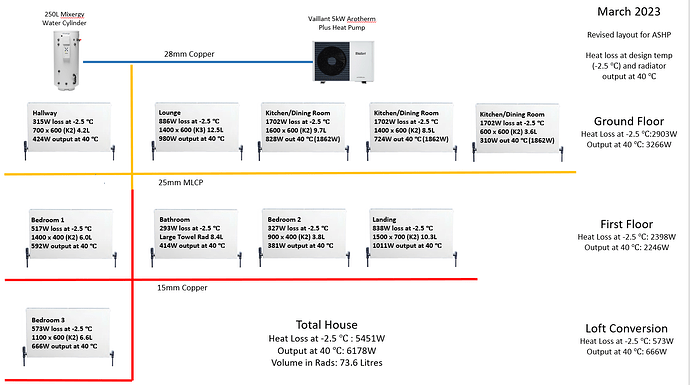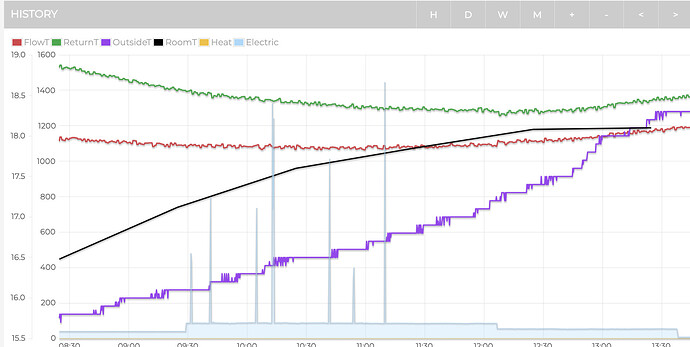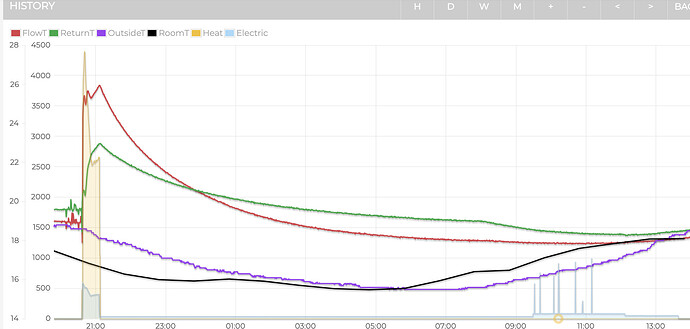I’m about to have my gas boiler swapped for a Vaillant Arotherm Plus 5kW ASHP and have been keenly absorbing as much info. here and elsewhere as I can. I’ll be adding the ‘level 3’ heat pump monitoring package to add to my existing Solar / Battery monitoring platform. I’ve agreed to my installer’s inclusion of a 45 litre buffer tank and, while I originally wanted to run an ‘open’ system, for my particular application I can see the sense in it, despite the extra complexity and (some) losses. To some questions:
- Can I assume that the heat meter in the monitoring setup goes in the return pipework of the ‘house’ circuit rather than the heat pump side of the buffer? This way, if I can extract COP info. from the Vaillant’s integral controls (VRC720), I’ll expect it to be different than on the ‘house’ side of the buffer, as the flow temp. into the buffer will always exceed that of the outlet, if not by much.
- Currently my existing radiators are controlled on a room-by-room basis from my Loxone miniserver and associated wireless radiator valves. With the ASHP, I propose to apply room set points a bit higher than required temperature (as upper temp limits), then let the Vaillant controls run the system purely on weather compensation and flow temp. I’ll need to tune this to achieve some night set back in the bedroom(s) but expect the Vaillant controls will do this. Bearing this in mind, does anyone have experience of post-ASHP installation and integration (or otherwise) of third-party room controls? Also, where do you generally locate the Vaillant ‘thermostat’ controller? I realise it’s wireless and can be moved, but (again, without experience) assume it’s placed in a ‘living’ space.
I’ll be adding my setup to the HeatpumpMonitor.org site as soon as possible and will continue to learn from others’ experiences here. Some other info. in case it’s useful:
1930s end-of-terrace 3 bed house with (early) cavity-foam insulation, 300mm loft insulation, Roof re-battened/tiled 2022 with TLX Gold quilted membrane (felt replacement). Lounge suspended floor foam-insulated 2023 with Q-Bot underfloor robot application - very effective and minimal disruption. Modern kitchen extension 2015. I live alone, so heating system tweaking can be done with impunity - unless visitors!
Radiators throughout, 2 replaced with ASHP install; others might need updating after monitoring system temps, COP and responsiveness. Heat loss calcs. including radiator sizing using Heat Engineer software. Overall heat loss around 45W/m2 from calcs and historic gas consumption. Last winter boiler range-rated to minimum (7kW) and run at 40-50 deg. flow temps which seemed acceptable.
Domestic hot water is provided by a 7kWh Sunamp ‘Thermino’ heat battery which will be fed from the ASHP as well as excess solar / off-peak grid top-up via MyEnergi ‘Eddi’ diverter. Sunamp was chosen as no convenient room for HW cylinder. I’ll be interested to see what the cost-difference is between charging the Sunamp with the ASHP (COP about 3??) or using 12p/kWh (Octopus GO) cheap rate 4 hrs overnight in winter. DHW load is covered May - Sept with excess solar.
3.5kWp rooftop solar and Givenergy 3kW inverter and 8.2 KwH attic-mounted battery.
EmonTX3 and EmonPi monitoring solar/home/divert etc.



